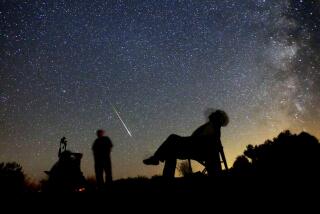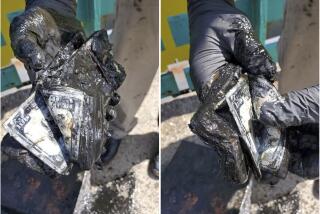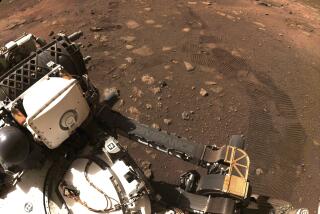Meteorite hunters strike pay dirt
COLOMA-LOTUS VALLEY, Calif — In the week since a fireball shot across the sky and exploded, scattering a rare type of meteorite over California’s Gold Country, these hills have drawn a new rush of treasure seekers.
Once again there are lively saloons, fortune hunters jockeying for prime spots and astounding tales of luck — including that of Brenda Salveson, a local who found a valuable space rock while walking her dog Sheldon, named after the theoretical physicist on the TV show “The Big Bang Theory.”
It started April 22, Earth Day, with a blazing streak across a morning sky and a sonic boom that the next day had the older women in the “Gentle Stretching to Beautiful Music” class at Sierra Ballet comparing notes on how hard their windows shook.
PHOTOS: Meteorite found in Coloma
Eight hundred miles away, while windows were still rattling, Robert Ward in Prescott, Ariz., was getting alerts. A 35-year-old professional meteorite hunter and dealer, he pays for tips and keeps a bag packed, ready to go anywhere in the world to chase a meteorite.
On Tuesday, after 16 hours of driving, he scanned a parking lot in Lotus in the pre-dawn not knowing what type of rock he was seeking. But when he spotted a dark space pebble, he immediately recognized it as carbonaceous chondrite, meteorites containing water and carbon — the type scientists long to study for insights into how life began on Earth and possibly in other places.
“I was trembling,” Ward said. “It’s the rarest of the rare. It’s older than the sun. It holds the building blocks of life.”
The rush was on. The meteorites are invaluable to science but on the open market can also fetch $1,000 a gram, or more for larger, pristine pieces.
In Vancouver, Canada, Paul Gessler, a part-time meteorite hunter, was readying for a halibut fishing tournament when he read about Ward’s find on a hobbyists Twitter feed. He took his fishing rod back to the house and told his wife he was driving to California.
At the NASA Ames Research Center north of San Jose, Beverly Girten, deputy director in charge of the center’s experiments on the International Space Station, announced she was going to Coloma. Her boss reminded her of a conference call about a $40-million budget. Girten said meteorites with organic compounds could prove more important to science.
In the Gold Rush town of Rescue (elevation and population both 1,400), Salveson, a wife and mother of two, read a local news article about the meteorites. The area scattered with them, about three miles wide and 10 miles long, included Henningsen Lotus Park, where she walks her dog every morning. She noted what to look for: a rock that seemed out of place — different from anything around it. It would be dark and delicate.
On Wednesday, near the end of her stroll with Sheldon, Salveson picked up a rock the size of a spool of thread that seemed to match the description.
She walked over to a group with metal detectors.
“I opened my hand and they all let out a collective gasp,” she said.
The geologists, as they turned out to be, wrapped the 17-gram stone in foil and told Salveson to get it into a bank vault.
A few minutes before, a firefighter had stopped to search at the park on his way to work and found a 2-gram meteorite in less than 20 minutes. A dealer paid him $2,000 on the spot.
Before going to the bank, Salveson made one stop: Rescue Elementary School. She had her children — Linnea, 10, and Tommy, 6 — and their classmates put their hands behind their backs. She pulled back the foil just a little and told them to look at perhaps the oldest thing anyone has ever seen.
Girten believes that should any of those children grow up to take a college earth science class, they might study this meteorite. Until now, the most studied meteorite has been the Murchison, found after a witnessed shower in Australia in 1969. All indications are that the Sutter’s Mill meteorite will replace it as the meteorite most known by name to anyone in science.
“We want to learn about this asteroid,” said Peter Jenniskens, an astronomer and senior research scientist at the Carl Sagan Center at the SETI (Search for Extraterrestrial Intelligence) Institute and the NASA Lunar Science Institute. “This is scientific gold.”
But the time window to get the clues from outer space into a lab is small.
Already, the chemistry of the rocks could be changing, and a heavy rain would dissolve them.
Saturday morning, Jenniskens asked for members of the public to meet at Marshall Gold Discovery State Historic Park and go out with him and other researchers to look for meteorites. The volunteers signed a form promising to turn over to NASA anything they found while with the scientists.
The majority of the individuals scouring grassy fields near where James Marshall found a piece of gold in 1848, or running metal detectors around canoes on the banks of the American River, did not sign on with the scientists, sticking to a prospector’s creed of each-for-his-own and finders keepers. The scientists got 30 volunteers.
Derek Sears, a NASA research scientist and editor of Meteorite magazine, led a for-research group that included George Cooper, a NASA expert in analyzing organic compounds in meteorites, and volunteers Collin Wadley, 12, and his father, Lee, up a steep red-earth trail framed in wildflowers.
“A large piece is out here somewhere,” said Sears. “I get goose bumps just thinking about it. We know so much about meteorites but understand so little. They can pull water from space. They may have formed the oceans. They may have seeded life.
“If nothing else, they are a witness ... to when the solar system was first formed.”
Earlier in the morning, Sears had encouraged Salveson to ensure that her meteorite goes to science.
“We’re paupers, but what can I do to get that meteorite for research?” he asked.
Sears, with a British accent and in a crisp blue shirt, was standing next to Michael Farmer, a commercial meteorite hunter in camouflage and need of a shower. He’s the sometimes partner of Ward, the meteorite dealer. They once spent two months in prison in Oman, charged with smuggling meteorites.
“Did my friend with the CIA contacts reach you?” Farmer asked Salveson. “He has a lot of resources. He can pay.”
A person’s universe can sometimes shift swiftly. Salveson’s week went from hoping to get caught up on laundry to having long talks with NASA and offers in the tens of thousands of dollars for the meteorite.
She pointed out that the town of Rescue was named by a man who found a piece of gold that “rescued” his family. But she hasn’t decided what she will do yet.
“I went from first hearing how much money it was worth to finding out the awe of it. I’m amazed at the journey it’s taken to fall to Earth before I picked it up,” she said.
“I’m glad I found it. But I’m also just glad it was found. It’s an astonishing thing.”
More to Read
Sign up for Essential California
The most important California stories and recommendations in your inbox every morning.
You may occasionally receive promotional content from the Los Angeles Times.











